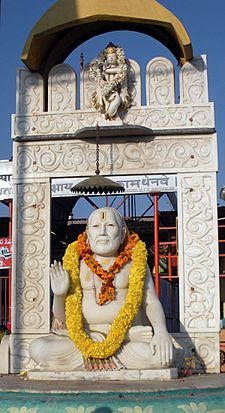Raghavendra Tirtha facts for kids
Quick facts for kids Raghavendra Tirtha |
|
|---|---|
 |
|
| Birth Date | 1595 or 1598 Bhuvanagiri (now in Tamil Nadu) |
| Birth name | Venkatanatha Bhatta |
| Guru/teacher | Sudheendra Tirtha |
| Philosophy | Dvaita Vedanta |
| Titles/honors | Parimalacharya |
Raghavendra Tirtha (Śrī Rāghavēndra Tīrtha) was a very important Hindu scholar, teacher, and saint. He lived from about 1595 to 1671. People also knew him as Sudha Parimalacharya.
He wrote many books, including explanations of the works of other great thinkers like Madhva. He also wrote about the Principal Upanishads from the viewpoint of Dvaita, which is a specific way of understanding Hindu philosophy.
Raghavendra Tirtha was the head (called a pontiff) of a special religious center (a matha) in Kumbakonam for 50 years, from 1621 to 1671. He was also a talented player of the Veena, a stringed instrument. He even wrote several songs using the name Venu Gopala. Today, his shrine in Mantralayam is a very popular place. Hundreds of thousands of people visit it every year.
Contents
Early Life and Journey
Sri Raghavendra Swami was born as Venkatanatha in a town called Bhuvanagiri, Tamil Nadu. His family was known for being musicians and scholars. They believed that his birth was a blessing from Lord Venkateshwara.
His great-grandfather, Krishna Bhatta, was a teacher to the king Krishnadeva Raya of the Vijayanagara Empire. His father, Thimmanna Bhatta, was also a skilled scholar and musician. After the Vijayanagara Empire ended, his parents moved to Kanchi.
Venkatanatha had two siblings, Gururaja and Venkatamba. Sadly, his father passed away when Venkatanatha was young. His brother-in-law, Lakshmi Narasimhacharya, took care of his education in Madurai. Later, Venkatanatha got married.
Becoming a Leader and Traveling
In 1624, Raghavendra Tirtha became the head of the Kumbhakona Matha. This religious center is now known as Raghavendra Matha. After staying in Kumbakonam for a short time, he went on a long journey.
He visited many holy places like Rameshwaram, Ramnad, Srirangam, and Mathura. Then, he traveled west to Udupi and Subramanya. He also visited Pandharpur, Kolhapur, and Bijapur.
It is said that he stayed in Kolhapur for a long time. In Bijapur, he is believed to have debated with many scholars who followed a different philosophy called Advaita Vedanta. He convinced some of them to follow the Dvaita teachings. After his travels, he returned to Kumbakonam.
By 1663, he moved to Mysore. There, he received support from a ruler named Dodda Devaraya Odeyar. Finally, he decided to settle down in a village called Mantralayam.
Raghavendra Swami passed away in 1671 in Mantralayam. This village is located on the banks of the Tungabhadra River in Andhra Pradesh.
His Writings and Teachings
Sri Raghavendra Swami is credited with writing about 40 different works. Scholars say his writings are clear and simple. They explain difficult ideas of the Dvaita philosophy in a way that is easy to understand.
One of his important books is Tantradipika. In this book, he explains the Brahma Sutra from the Dvaita point of view. He also included ideas from other great thinkers.
Another work, Bhavadipa, explains a text called Tattva Prakasika. In this book, he not only clarifies the original ideas but also responds to criticisms against Madhva.
Raghavendra Swami was also an expert in other areas of Hindu knowledge, like Purva Mimamsa and Vyakarana (grammar). This is clear from his detailed writings. He wrote a commentary on Nyaya Sudha called Nyaya Sudha Parimala.
Besides these, he wrote explanations of the Upanishads, the first three chapters of the Rig Veda, and the Bhagvad Gita. He also wrote an independent book called Bhatta Sangraha. This book explains the Purva Mimamsa teachings from a Dvaita perspective.
A Special Meeting with Sir Thomas Munroe
There is a famous story about Raghavendra Tirtha. Even though he passed away in the 17th century, it is recorded that he appeared and spoke to Sir Thomas Munroe. Sir Thomas Munroe was a British government official in the 19th century.
They talked about some land that the government was planning to take back. This land included Mantralayam. After their conversation, which Sir Thomas Munroe wrote down, the plan to take back the land was stopped.

